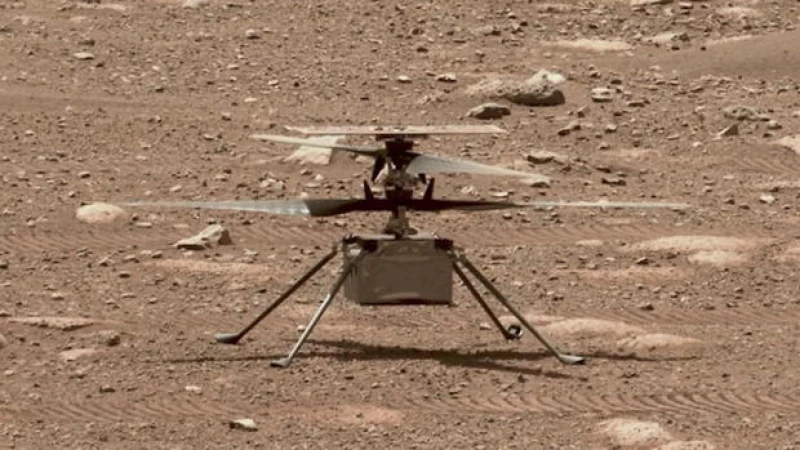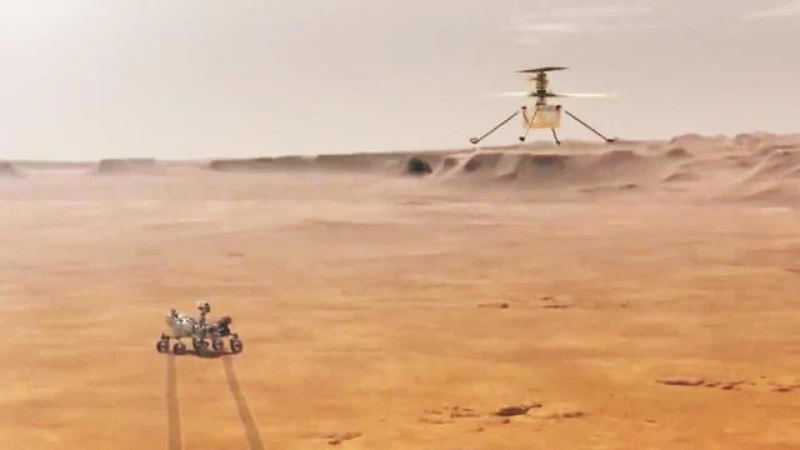In the year 2020, a remarkable event took place as NASA's Perseverance rover set off for Mars accompanied by a tiny drone. This drone, known as Ingenuity, was crafted by NASA's Jet Propulsion Laboratory in Pasadena, California, and was compared to the Wright Brothers' plane for its historic flight on the red planet.
Given that Mars has a mere 1% of Earth's atmosphere, Ingenuity had to be extremely lightweight at just four pounds to navigate the challenging flying conditions. NASA designated Ingenuity as a tech demo, a cost-effective and risky side project that utilized off-the-shelf components to save on expenses.

Despite its eventual success, project manager Teddy Tzanetos revealed that not everyone supported the concept of including Ingenuity as a stowaway technology demo. Some individuals vehemently opposed the idea, believing it diverted resources from the primary goal of Mars 2020: collecting samples for eventual return to Earth.
- How NASA's Perseverance rover will send Martian rocks back to Earth for the first time ever
In the end, NASA decided that Ingenuity could fly, briefly – five times, tops, in the first 30 days. After that, no more distraction from the main mission.
By some miracle, Ingenuity survived the seven-month journey to Mars, the landing sequence, and the drop-off.
- "Touchdown confirmed!": NASA celebrates as Perseverance rover lands on Mars
The distance between Mars and Earth means it takes up to 20 minutes for a signal to reach the helicopter. So, every instruction would have to be transmitted in advance. "We'll uplink a flight on Monday and, if we're lucky, we'll get the data on Tuesday, sometimes it's longer," said chief engineer Travis Brown.
So, no one may know whether it was a smoking heap of wreckage on Mars until days later.
On April 19, 2021, the team received confirmation of the drone's very short first flight – the first flight of a powered aircraft on another planet! But the hardest part wasn't flying; it was surviving the frigid Martian nights, which can fall to -80° Fahrenheit.
- How NASA flew a drone on Mars ("60 Minutes")
"The joke is that Ingenuity is a battery and a heater that happens to fly once in a while," said Brown. "Most of the mass is battery, and most of that battery is actually spent heating."

Despite the cold, the helicopter flew four more times – five flights in all. Mission complete! But then, an administrative miracle: "When people saw this thing flying and taking pictures, you know, I think everybody realized this is more than just a toy, this is a real flying machine," said Håvard Grip, who was Ingenuity's chief pilot. "NASA told us, 'Hey, you guys get to continue, okay? Can you scout on behalf of the rover so we can see where the best ingress points are into this area?"
Ingenuity was no longer a tech demo. NASA promoted it to be the rover's eye-in-the-sky, scouting ahead to help the rover choose its routes and destinations.
So, Ingenuity kept flying, kept beating its own records for distance, speed, altitude and duration. And not just for 30 days … for a hundred. Two hundred. Four hundred. Through the long Mars spring, summer and fall.
- Mars Ingenuity helicopter breaks record for speed and altitude, NASA says
But then, winter came.
On Day 427 of the mission, there was radio silence from Ingenuity. "And so, the first thing you're thinking is, 'Okay, well, battery froze, everything broke, we're probably dead," said Brown. "Mission's over, right?"
For three days, the team tried to get a response. And then, on the third day, another miracle. "Lo and behold, it came back and talked to us!" said Grip.
Tzanetos said, "In the morning when the sun rose and the system thawed and charged up enough, the electronics turned on. And we'd say, 'Here's your flight plan, go ahead and fly now late in the afternoon.' And she'd do that flight, knowing full well – the controllers here on Earth – that she would freeze again the next day."
Ingenuity's Winter Survival Story
During the winter, Ingenuity faced a unique challenge - freezing to death every night and thawing again in the morning. "Yeah, hundreds of times!" Brown chuckled.
"It was like Groundhog Day," remarked Tzanetos, "until finally you got through winter and you got to spring again."

However, Ingenuity's luck ran out this past January when NASA received the unfortunate news that it had suffered a hard landing. "The top blade is clipped on one side and completely missing on the other," explained Brown. "We're missing enough of the rotor system, there's no way she'll ever fly [again]. But I mean, this thing is still ticking. We can still collect solar data. We can take pictures still."
Despite the setback, three years after its mission was supposed to end, Ingenuity is still operational, now functioning as a ground station. While we no longer receive its photos and measurements, Ingenuity could continue collecting data for decades to come, to be retrieved later.
Tzanetos shared, "We have a phrase on the team: 'WNDY: We're not dead yet.'"
The remarkable "little copter that could" has forever altered NASA's perspective. "We've been developing the next generation of helicopters for Mars – larger, more capable helicopters, [to] explore areas like a cliff wall, fly down a lava tube, reach the poles, reach the equator, you name it," Tzanetos shared.

Regarding the Wright Brothers analogy? It appears the Mars stowaway helicopter carried a stowaway of its own: Tzanetos revealed, "The fabric used for the wings on the Wright Brothers flyer, we have a little piece about the size of a quarter underneath the solar panel of the helicopter, and it's our little good luck charm, and ballast, for the baby."
And did everybody in the chain of command know about this? "No, no, no. I'm sworn to secrecy about certain details for that, but no, the entire chain was not aware of that," Tzanetos disclosed.
- NASA's Perseverance Mars rover hitting paydirt in search of clues about possible past life
- NASA rover unravels history of lake on Mars that grew up to 22 miles wide, 100 feet deep
In total, Ingenuity completed 72 flights over a thousand days, accumulating over two hours of flight time in the thin atmosphere of Mars, covering more than 10 miles across the Martian terrain. Brown attributed this success to "a small, scrappy team of engineers, very, very passionate about what they were doing."
Tzanetos emphasized, "It has a special place in the history of NASA for being the first flight on another planet."
"The level of astonishment among all of us is beyond words," expressed Grip. "None of us saw this coming, and we are incredibly proud of the achievement."
For additional information:
Story crafted by John Goodwin. Edited by Ben McCormick.







